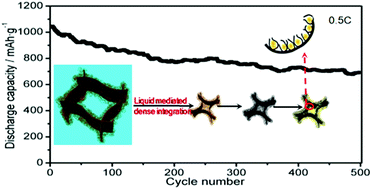A dual-spatially-confined reservoir by packing micropores within dense graphene for long-life lithium/sulfur batteries†
Abstract
In lithium/sulfur batteries, micropores could bring about strong interactions with polysulfides, but could not alleviate the partial polysulfide overflowing outside because of the volume expansion of the lithiated sulfur. A dual-spatially-confined reservoir for sulfur by wrapping microporous carbon with dense graphene, micro@meso-porous DSC (dual-spatial carbon), is synthesized to solve this issue. Such a structure is prepared through two distinctive methods: graphene promoted in situ hydrothermal carbonization of organics to grow micropores on itself, and liquid mediated drying of graphene hydrogel to form mesoporous graphene frameworks. In contrast to previously reported hierarchical carbon/S, the inner micropores are mainly responsible for loading sulfur, which could help confine its particle size, thus increasing the electrical/ionic conductivity and the utilization of sulfur, and restrain lithium polysulfide dissolution because of strong interaction with pore walls; while the outer mesopores act as another reservoir to stabilize the overflowed polysulfide and to enhance the Li+ transport. The S-micro@meso-porous DSC cathode exhibits better discharge capacity and cycling performance than S-microporous AC and S-micro@macro-porous DSC, i.e., 59% and 37% higher capacity remaining at 0.5 C than the latter two, respectively.



 Please wait while we load your content...
Please wait while we load your content...